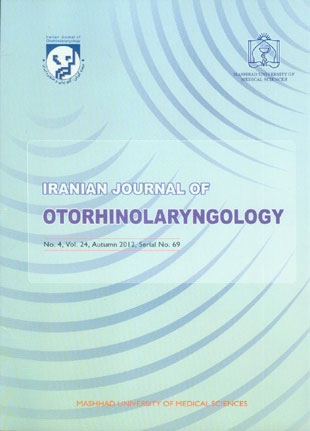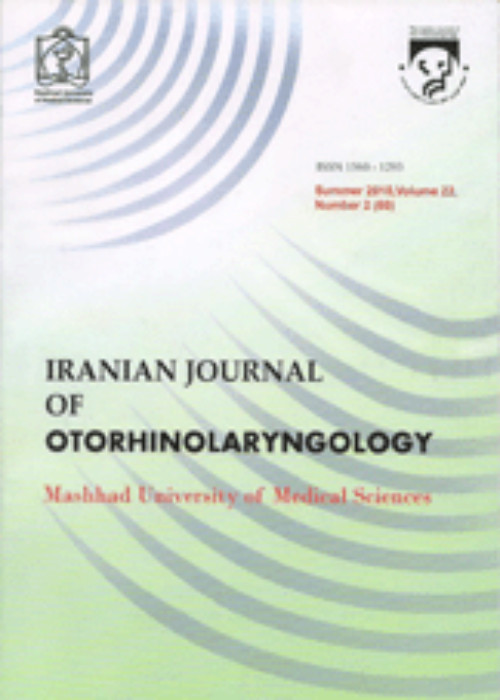فهرست مطالب

Iranian Journal of Otorhinolaryngology
Volume:24 Issue: 4, Autumn 2012
- تاریخ انتشار: 1391/06/28
- تعداد عناوین: 9
-
-
Page 155IntroductionIt has been shown that low levels of pigmentation increase susceptibility to noise-induced hearing loss in humans. For this reason, white populations develop more pronounced noise- induced hearing loss in comparison to black populations. Similarly, blue-eyed individuals exhibit greater temporary threshold shift than brown-eyed subjects; still, no strong correlation has been verified between the lightness of hair color and susceptibility to noise-induced hearing loss. This study was performed with the purpose of investigating a possible association between hair color and the degree of hearing loss due to firing noise. Study Design: Prospective observational study. Setting: A tertiary referral center with an accredited otorhinolaryngology-head & neck surgery department.Materials And MethodsA total of 57 military recruits were divided into two groups; light-colored (blond and light brown) and dark-colored hair (dark brown and black). The two groups were matched based on history of firing noise exposure (number of rounds; type of weapon) and the level of hearing loss at 2, 3, 4, 6 and 8 kHz sound frequencies was compared between them.ResultsThe results showed that the mean level of hearing loss of light-colored hair individuals (20.5±17dB) was significantly greater than that of dark-haired subjects (13.5±11dB), (P=0.023).ConclusionThe results indicate that hair color (blond versus black) can be used as an index for predicting susceptibility to noise-induced hearing loss in military environments. Therefore, based on the individual's hair color, upgraded hearing conservation programs are highly recommended.Keywords: Hair color, Pigmentation, Noise, induced hearing loss, Susceptibility
-
Page 161IntroductionHER2/neu, a member of the epidermal growth factor receptor family, has been shown to be over-expressed in some tumors. The purpose of this study was to determine the salivary levels and tissue expression of HER2/neu in patients with head and neck squamous cell carcinoma (HNSCC) and their correlation with clinicopathologic parameters.Materials And MethodsEnzyme-linked immunosorbent assays (ELISA) were used to evaluate the salivary levels of HER2/neu and immunohistochemistry was used to measure tissue expression of HER2/neu in 28 patients with HNSCC and 25 healthy control subjects.ResultsThe salivary levels of HER2/neu in patients with HNSCC were not significantly higher compared to healthy control subjects. There was no apparent correlation between salivary HER2/neu levels and clinicopathological features such as age, sex, tumor grade, tumor size and nodal status. All HNSCC specimens were positive (membranous or/and cytoplasmic) for HER2/neu, except one sample. Only one HNSCC specimen showed staining purely in the tumor-cell cytoplasm. All control specimens were also positive for both membranous and cytoplasmic HER2/neu but there was a significant difference between the level of cytoplasmic staining in the HNSCC specimens and in the control specimens (P<0.05).ConclusionIn our study, no overexpression of HER2/neu was observed. Thus, identification of HER2/neu levels plays no role in differentiating between normal and squamous cell carcinoma tissues or detecting the carcinogenesis process. Our findings suggest that the use of HER2/neu as a salivary marker of HNSCC is not recommended, because no significant preoperative elevation and no association with clinicopathological features were found.Keywords: Carcinoma, HER2, neu, Salivary Gland, Squamous cell of head, neck, Tissue expression
-
Page 171IntroductionOtalgia is one of the complaints which may occur at any age. The etiology of the pain may be in the ear, structures around the ear or other head and neck structures. This is caused by the complex nervous connections in the head and neck areas, the ear, the pharynx and the nose. Since understanding the etiologies of referred otalgia can help in the assessment and treatment of the disease, this research was conducted to identify the etiologies of referred otalgia in patients visiting the ENT Clinic in Gorgan, Iran.Materials And MethodsThis prospective research was conducted on patients who visited the ENT Clinic with an earache, but in initial assessments the ear was normal. Patients’ data consisting of sex, age, complaint, the inflicted side, physical findings in the ear, the nose, the throat and head and neck were recorded in a questionnaire. These data were then analyzed with SPSS software.ResultsOf 770 patients with otalgia, 94 patients (12.2%) had referred otalgia. Of these patients 27.7% were men and 72.3% were women. The most common etiology of referred otalgia was dental problems (62.8%), and one patient who was being treated for pharyngitis had carcinoma of the base of the tongue. In 47.8% of cases the pain was in the left ear, in 43.4% in the right ear, and in 8.7% it was bilateral.ConclusionIn view of the fact that a significant proportion of the patients who complained of otalgia had no pathologies in the ear, thorough physical examination in adjacent structures especially teeth should be performed and malignancies should be considered as a possible etiology of otalgia.Keywords: Cases, Earache, Pain, Referred
-
Page 177IntroductionSurgery for revision of cochlear implantation is an unusual but not uncommon occurrence. The purpose of this study was to discuss the major complications of cochlear implantation that we observed in 11out of 275 patients who underwent cochlear implantation in Khalili Hospital at Shiraz University of Medical Sciences.Materials And MethodsA retrospective analysis of 275patients who underwent cochlear implantation between 2003 and 2009 was performed. All of the patients were followed for one to five years.ResultsOnly 11 patients needed to undergo revision surgery or take medication. Out of those, five patients were referred with signs of device failure, all of whom underwent reimplantation. For the rest of the patients with complications, one patient underwent surgery due to a misplaced electrode, two patients had poor telemetry due to migration of the implant magnet, one patient presented with meningitis that was managed by medical treatment, and two patients presented with a massive scalp hematoma that responded to medical treatment.ConclusionsIn our study the most common cause of a need for cochlear reimplantation was device failure.Keywords: Cochlear implantation, Reimplantation, Revision surgery
-
Page 181IntroductionTo study the long-term complications of tympanostomy tube insertion in young children 10 years after surgery.Materials And MethodsIn September 2011, the medical records of all patients who had undergone myringotomy with tympanostomy tube insertion between February 2000 and March 2001 at the two general hospitals of Isfahan University of Medical Sciences were studied. Of the 98 patients who fulfilled the inclusion criteria, 82 patients agreed to participate and were enrolled in the study. The complications of the operation were evaluated in these patients.ResultsOf the 164 ears that were operated on, myringosclerosis was found in 17.1%, atrophy of the tympanic membrane in 1.2%, permanent perforation of the tympanic membrane in 0.6% and tympanic membrane atelectasis in 0.6%. None of the patients developed cholesteatoma as a complication of tympanostomy tube insertion.ConclusionConsidering the low risk of serious complications after 10 years, tympanostomy tube insertion is a safe and effective treatment option in the treatment of otitis media with effusion.Keywords: Myringotomy, Myringosclerosis, Otitis media with effusion, Perforation, Tympanostomy tube
-
Page 187IntroductionA cleft lip with or without a cleft palate is one of the major congenital anomalies observed in newborns. This study explored the risk factors for oral clefts in Gorgan, Northern Iran.Materials And MethodsThis hospital-based case-control study was performed in three hospitals in Gorgan, Northern Iran between April 2006 and December 2009. The case group contained 33 newborns with oral clefts and the control group contained 63 healthy newborns. Clinical and demographic factors, including date of birth, gender of the newborns, type of oral cleft, consanguinity of the parents, parental ethnicity, and the mother's parity, age, education and intake of folic acid were recorded for analysis.ResultsA significant association was found between parity higher than 2 and the risk of an oral cleft (OR= 3.33, CI 95% [1.20, 9.19], P> 0.02). According to ethnicity, the odds ratio for oral clefts was 0.87 in Turkmens compared with Sistani people (CI 95% [0.25, 2.96]) and 1.11 in native Fars people compared with Sistani people (CI 95% [0.38, 3.20]). A lack of folic acid consumption was associated with an increased risk of oral clefts but this was not statistically significant (OR = 1.42, CI 95% [0.58, 3.49]). There were no significant associations between sex (OR boy/girl = 0.96, CI 95% [0.41, 2.23]), parent familial relations (OR = 1.07, CI 95% [0.43, 2.63]), mother's age and oral clefts.ConclusionsThe results of this study indicate that higher parity is significantly associated with an increased risk of an oral cleft, while Fars ethnicity and a low intake of folic acid increased the incidence of oral clefts but not significantly.Keywords: Cleft lip, Cleft palate, Consanguinity, Ethnicity, Folic acid, Parity
-
Page 193Congenital epulis is a very rare benign soft-tissue tumor of uncertain histogenesis, which is also known as “gingival granular cell tumor of the newborn”. It occurs almost exclusively as a single tumor along the alveolar ridge of the maxilla in newborn females. Although congenital epulis is strikingly similar to the more common adult granular cell tumor histologically, in contrast to the latter congenital epulis cells are negative for S-100 protein. This case report describes a 15-day-old female infant with multiple congenital epulis of the mandibular alveolar ridge.Keywords: Congenital epulis, Congenital gingival granular cell tumor, Mandible
-
Page 197IntroductionThe healing process after surgery is a challenging issue for surgeons. Various materials and techniques have been developed to facilitate this process and reduce its period. Fibrin adhesives are often used in cardiothoracic and vascular surgery to seal diffuse microvascular bleeding and in general and plastic surgery to seal wound borders. This Case report and literature review will introduce the various usages of platelet-rich fibrin in different surgical procedures and the method of producing the matrix.Case Report:A 24-year old man with periorbital skin avulsion treated with PRF membrane has been reported and discussed in this paper.ConclusionPlatelet-rich fibrin is a natural autologous fibrin matrix, which can be produced with a simple blood sample and a table centrifuge. The material has been used in a wide range of surgical procedures to shorten the healing period and reduce post-surgical complications.Keywords: Blood sample, Fibrin matrix, Healing, Platelet, rich fibrin, Surgery
-
Page 203


